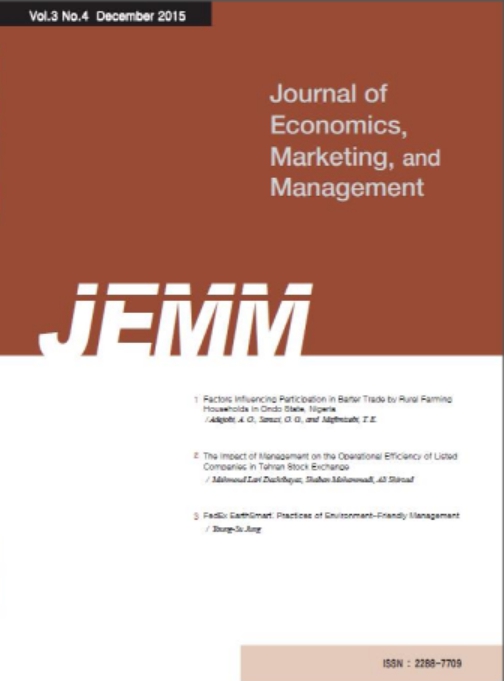- Log In/Sign Up
- E-ISSN2288-7709
- KCI
 E-ISSN : 2288-7709
E-ISSN : 2288-7709
Vol.4 No.1
Abstract
The purpose of this paper is to discuss the methodology of optimizing delivery route scheduling using a capacity integer linear programming problem model developed to a previous case study. The methodology suggests a two-stage decision: the first, automatic, where the manager will obtain guidance generated by the solution of the linear programming model, later they could use post-optimization techniques to fine tune to the best operational solution. This study has the goal to reduce the size of service companies' ground transportation fleets, aiming not only to reduce costs and increase competitive advantages but also to lower levels of air pollution and its consequences, traffic and, therefore, the levels of carbon dioxide, allowing for a reduction in envir onmental disasters.
Abstract
This study tried to examine how interdependence, communication, and the exercise of power in cosmetics distribution channel would affect satisfaction. In this study we investigated the effects of their communication and the exercise of noncoercive power of department store (or mart). We conducted with managers of the shops which were entered to department store (or mart). 131 copies were collected and 119 copies were used for analysis after the exclusion of 12 copies. Brand image and sales policy influenced satisfaction, but customers were not statistically significant. In addition, communication in distribution path had the moderating effect on the relationship between interdependence and satisfaction, and on the relationship between interdependence and noncoercive power. Sales policy and brand image in the relationship between department store(or mart) and the shops opened inside are critical factors for satisfaction, but customers are highly likely to become a factor with different meaning.
Abstract
Sales promotion is defined as the short-term incentive to encourage the purchase or sale of products and services. Retailers conduct a variety of sales promotion to encourage the purchase or sale of products and services. It is often used to induce the purchase of customers in short term and to improve the relationship with customers in the long term. Many previous studies about the effect of price discount SP on increase in sales and image improvement have conducted. But the study of non-price promotion, especially SP with 'Gifts', meanwhile, has been seldom researched. This study is to investigate the effect of the Gift SP conducted by retailers on the customer evaluation of the product and its Gifts. This study is to investigate the effect of 'Gifts', among the non-price promotion, on the customer evaluation. First of all, previous studies about the effect (-) of Sp with 'Gifts' on the customer evaluation of the product and its Gifts, and the factors that offset the negative effect of SP with 'Gifts' on quality perception are to examined. In this study, additionally, the summary of the study based on the previous studies and the research subject in the future are to be presented. Firstly, to examine the previous researches on the effect of SP which retailers conduct on the increased sales and or enhanced image, price discount SP has attracted a lot of attention as a research subject but researches on non-price sales promotion, particularly on SP with gift have seldom conducted as a research subject. Secondly, in the previous studies relevant to Price Discount SP, the long-term negative (-) effect of the target product or brand of SP has been studied. However, a few researches on the long-term negative (-) effect of SP with gift have been conducted. Thirdly, it might be brand affinity and purchase limit that buffered the negative (-) effect on the perceived quality of SP with gift which retailers had conducted. In spite of various studies conducted by many researchers, each study have discussed the consequences under certain circumstances and integrated results of research have not been in progress. It may be the research issues left to us to clearly identify the psychological mechanism of consumers until the effect of SP happens in order to theorize SP and to present a practical and useful suggestion.













